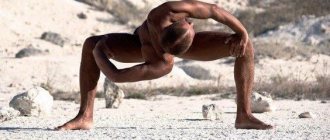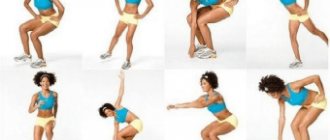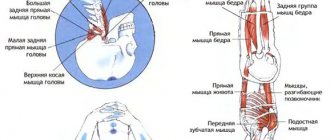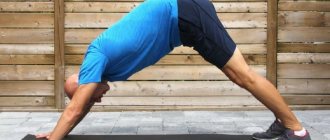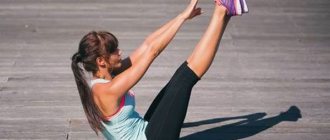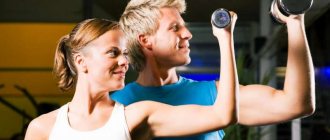Hatha yoga
“In Sanskrit, hatha means strength, and the word itself consists of two parts: “ha” is translated as “sun”, and “tha” is “moon,” says Bridget Woods Kramer, considered one of the most experienced yoga teachers with more than than 40 years of experience. — In hatha yoga, the main emphasis is on strengthening the physical capabilities of the body in order to prepare it for spiritual practices: the higher the control over your material shell, the easier it is to achieve mental maturity. Hatha promotes blood circulation in the body, improves the functioning of the lymphatic system, and also calms the mind and helps put thoughts in order. Depending on the techniques used, it can have both a calming and tonic effect.”
Girls practice yoga at Everywoman's Village school
“The main principles of hatha yoga are the performance of static poses (asanas), breathing practices (pranayama), meditation and control of energy flows, or kundalini (kriya). Ideally, you should devote at least 15–20 minutes to exercise every day: sometimes just one restorative pose is enough to help restart the nervous system. At first, I don’t recommend striving for perfect execution—start with short, simple movements, accompanying them with breathing practices.”
Goasana (table pose)
Increases intra-abdominal pressure. Eliminates spinal deformity. Restores and rejuvenates the deep-lying muscles of the back and abdomen. Relaxes the stomach and intestinal system. Opening of the pelvic bones. In this case, on your elbows, it helps with constipation and doesn't overwork your wrists.
Performance:
stand straight, legs slightly apart, arms at your sides. Get down on your knees, stretch your arms forward, lean forward and place your elbows on the floor, head freely lowered, back straight, stomach tucked, attention focused on the abdominal muscles. Lock the position for 1-2 minutes and lower yourself onto your heels, rest for 10-15 seconds and repeat the movement 1-2 more times.
Kundalini yoga
“It's a very dynamic class,” says certified kundalini yoga instructor Caroline Cowan, who conducts masterclasses and workshops in the UK. “They include a lot of chanting, breath work and mindfulness exercises. At the beginning of each lesson, the teacher sets a specific topic, which runs like a red thread through all asanas, breathing practices and meditations.”
“I see the main advantage of kundalini that it helps to gain confidence and make friends with other people. In my classes you can meet people of any size, gender and profession: men and women from 10 to 85 years old come to me, dressed as they feel comfortable, be it tight leggings or a loose tracksuit. Body image is still a big issue in modern society, but in my experience, our appearance doesn't really matter."
Marichiasana (deep twisting pose)
Improves intestinal function, relieves acute pain in the back, lower back and hips, heals sprains of the shoulder ligaments and displacement of the shoulder joints, loosens the shoulder girdle.
Performance:
sit down, bend your right leg, pointing your knee up. Place your right foot behind your left thigh. And extend your left leg forward. Place your right hand on the floor behind you. Twist towards your bent leg, helping yourself with your left hand. Your task is not to twist as tightly as possible, but to stretch your head up. Fix the asana for 30-40 seconds and repeat in the other direction. It is advisable to start all twists on the right side.
Restorative yoga
Restorative yoga is based on a set of techniques for treating people with chronic diseases. But such exercises will also be useful for those who do not experience health problems - they are believed to help calm the mind.
Photo: Arthur Elgort
“The primary goal of restorative yoga is to calm the nervous system,” says Anna Ashby, who has been working as a trainer in the US and UK for 25 years. — Usually training lasts no more than an hour and is designed to perform only four asanas, the effect of which is consolidated through meditation. A calm, moderate rhythm of classes is important - it is advisable to conduct them in a room with dim lighting and the most peaceful atmosphere possible.”
“Restorative yoga is an ideal option for those who want to learn to hear themselves and achieve absolute harmony at all levels of consciousness. It will take time to make the switch and let go of chronic stress, but at some point, feeling calm will become your new normal—an amazing feeling.”
Alessandra Ambrosio
What is yoga for special children
There are many “special needs”; they can be associated with physical disorders (cerebral palsy, diseases of the musculoskeletal system, limited health) and specific mental and mental development (mental and speech delays, general speech underdevelopment, early childhood autism, Down syndrome , attention deficit disorder with and without hyperactivity). There are many features and developmental disorders; children and adolescents with similar diagnoses often do not fit into the framework of descriptions and symptoms
One thing is important: they are all children, and, like ordinary children and adults, they differ in character, personal characteristics, habits, likes and dislikes. They just live with restrictions
What can yoga give them?
In general, it is the same as yoga for non-special children and “ordinary” adults: a way to understand, feel your body, learn to help it (and yourself) live joyfully. In scientific terms, this can be called a developmental or correctional-developmental rehabilitation program, including elements of training and education.
With serious practice, both children and adults can become imbued with the philosophy of yoga, and can use it as therapeutic and preventive physical education, which has a beneficial effect on the psyche. Independent removal of muscle tension, proper breathing, relaxation techniques - this is what the basic course is based on. And special children especially need it.
Yoga for pregnant women
Nadya Narain has been teaching yoga for more than 20 years and specializes in classes for expectant mothers, works as a qualified hypnobirthing instructor, writes books, produces video guides and even acts as a doula. “Unless you have any special medical contraindications, yoga during pregnancy is absolutely safe,” she assures. “The classes are aimed primarily at developing physical strength, but also help to establish a connection with the child and one’s own body.”
“The workouts for pregnant women are selected in such a way that they are comfortable for girls to attend at any stage and so that they can benefit from each asana. Plus, you're in a group of girls who are in the same position as you, it creates a sense of community.”
Paschimottanasana (seated bend to the feet)
Paschimottanasana is a therapeutic yoga pose for the spine. It eliminates stoop and curvature of the spine, rejuvenates the nerves of the spinal column, and has a beneficial effect on the genitourinary organs, intestines, pancreas, spleen, liver and stomach. The asana reduces appetite and improves digestion, tightens the hips and buttocks, reduces the amount of fat deposits on the abdomen, stimulates the endocrine system, and has a beneficial effect on the heart.
Performance:
Sit on your buttocks, straighten your legs. Point your toes toward you, pressing the backs of your knees to the floor. Grab your shins or knees with your hands - where your hands reach with your back straight. Helping yourself with your hands, stretch your back forward and up (but not down!), lengthening your spine. Then relax your back and lower it as low as possible towards your feet, continuing to pull the top of your head forward. Breathe freely for 30-60 seconds, gradually increasing the duration of the exercise. Slightly move your lower back back, raise your head and, bending in your chest and back, lift up vertebra by vertebra until your back reaches a vertical position.
Iyengar yoga
This direction is suitable for perfectionists who like to deliberately delve into the subtleties of asanas. The main goal of practice is to achieve ideal body position while performing exercises, so each lesson is devoted to only one position and several similar ones. In pursuit of the ideal stance, various devices that are used as support for the body will help. Despite its apparent complexity, students with any level of training can start practicing Iyengar yoga.
“Centrifuge” (modified cat pose)
Execution: rotation of the body around its axis in a circle. First clockwise 4 times.
Then counterclockwise, also 4 times. As you inhale, we make a semicircle that bends your back.
Exhale in a semicircle that rounds your back.
Try to perform this exercise carefully going through each degree of body rotation. 2 sets of 4 times each side.
Rocket yoga
This trend with a funny name was developed by Larry Schultz from San Francisco in the 1970s. This yoga is a mix of Ashtanga and Vinyasa flow practices with an emphasis on developing strength and endurance - for this, the practice includes several options for handstands, back exercises and asanas that require good stretching of the hip joints. It is recommended for people with a good level of physical fitness: if you are far from not only yoga, but also sports in general, it may be a little difficult for you.
Yoga in the Workplace: 7 Poses to Fight Stress
Sitting at a computer for many hours can result in neck, shoulder and back pain. Do this simple yoga routine right at your workplace, and you will experience less discomfort.
- Crescent Moon Pose on a Chair
. The side of your body tends to cave in when you're slouched at a computer, leading to discomfort in the neck and shoulder area. Crescent Moon Pose eliminates these problems, plus it stretches the spine, increases concentration and clears the mind. Raise your arms above your head and extend them, palms together, fingers spread wide. Lean to the right for 2-3 breaths. Do it the other way. - Wrist and finger stretching.
Working at a computer can put a lot of tension in the muscles and tendons of your fingers, hands, and wrists. Do these stretching exercises every 2 hours. Extend your arms forward or up and make 5-10 circles with your wrists inward and outward. Then quickly spread your fingers out and form fists several times, repeating this movement 5-10 times to get rid of excess tension. Place your hands on the desktop, palms up and fingers facing you - you will feel gentle pressure on your wrist and forearm. Or you can extend your arm in front of you and first bend your wrist inward and then outward, stretching it with your other hand. Hold for 5-10 breaths on each side. - Pigeon Pose on a Chair
. When we cross our legs—especially if we do it more on one side than the other—we create imbalances in the lower back and hip joints. Pigeon pose on a chair will help bring the body into balance. Sitting on a chair with both feet on the floor, place your right leg on top of your left at a 90-degree angle. Keep your feet toned so as not to create unnecessary stress on your knee. Distribute your weight equally between your sit bones. Hold for 5-10 breaths and switch sides. - Chair Pose in dynamics
. When we sit all day, our glutes and hamstrings lose tone and motivation to help us stand, and we begin to rely on our upper back and even neck to pull us into a standing position. This pose helps awaken the leg muscles. Sit on a chair, knees bent at 90 degrees, feet flat on the floor. Push through your heels, being careful not to move your feet or help yourself with your hands, and rise to a standing position. From this position, sit slowly, keeping your back straight, without leaning forward or shifting your pelvis to any side. Repeat 5-10 times. - Chaturanga at the table
. A desk can be a great prop for doing push-ups. If you do them several times a day, the neck muscles will remember to relax - and the arm muscles, on the contrary, will be in good shape. This is worth getting out of your chair! Place your palms on the edge of the desktop (it should be stable!) shoulder-width apart, step your feet back so that your torso forms a diagonal line in relation to the floor. Feet are firmly on the floor. As you inhale, bend your elbows 90 degrees, pressing them toward your ribs. As you exhale, return up to the starting position. Repeat 8-12 times. - Upward facing dog at the table
. After the previous pose, you definitely need to open your chest and shoulders. You will also get rid of the slouching that often occurs in those who sit at the computer for a long time. Position yourself as recommended for Chaturanga. With straight arms, lower your pelvis closer to the table without transferring your weight to the lower back - use the strength of your legs. Stretch your chest between your shoulders and gently tilt your chin up, lowering your shoulder blades down. Hold for 5-10 breath cycles. - Plank pose at the table
. Please do not climb on your workbench to do the Plank. Instead, use a table to support this pose, which is great for stretching the spine and hamstrings. Place your palms shoulder-width apart or slightly wider on the edge of the table. Walk your feet back until they are directly under your pelvis and you feel a pleasant stretch in your back. Hold for 5-10 breaths and let this pose help you release the negative effects of a sedentary lifestyle.
Photo: istockphoto.com
Building a lesson
A standard workout consists of eight sequential stages.
- Warm-up
- Surya Namaskar (simplified version of Suryanamaskarasana)
- Asanas in a standing position
- Backbends
- Forward bends
- Twisting
- Inverted poses
- Shavasana - total relaxation
Each exercise should be done slowly, no more than three repetitions, controlling breathing and avoiding pain.
Add the load gradually with each new exercise to maximum difficulty, after which you need to reduce the intensity until complete relaxation.
Side bends with outstretched arms
Spending a long time at the computer causes discomfort and tension in the shoulder and neck joints. The popular “Half Moon” asana relaxes the shoulders and neck, relieves fatigue from the vertebrae and increases stress resistance. The pose can be done in a sitting position. Bending improves coordination and sense of balance. It is recommended to do this exercise for at least 5-10 minutes to feel the results and fill the body with energy. So, let's begin:
- Sit on a chair with your back straight.
- Exhale and raise your arms up with your fingers extended.
- As you exhale, bend to the left or right side without lowering your arms.
- Take a couple of breaths.
- Return to the starting position.
- Do the same with the other side.
Do at least 10 repetitions of this exercise. The result will be amazing!
Reviews
Real reviews from people involved:
Nina: Yoga has attracted me since childhood, but it always seemed like something accessible only to a select few. Then one day I came across the film “Best Friend,” where Madonna’s character taught a yoga class: I decided that I wasn’t. And I signed up for fitness yoga classes that opened right at the school where I work. This, of course, is far from classical yoga, but for me this is even a plus. I got into training right away. After the first one, my muscles ached, my body ached, but my soul sang. After 2 months - unexpected -6 kg on the scales. Six months later - a vacation in Greece with a completely full phone memory, because I have never taken so many photos in a swimsuit in my entire life!
Yana: I decided to start my path to yoga with fitness yoga. It is adapted to modern people, and I liked that. Our course was taught by a girl who lived in India for 4 years. But at the same time, she understood our capabilities and ignorance, and took into account the fact that we are still closer to physical education than to yoga. I studied 3 times a week in class (45 minute lesson), and 1 time at home - 30 minutes. A year and a half later, I started doing hatha yoga. Now I am an instructor myself.
Varvara: I go to fitness yoga with my mother, she is 55 years old, she retired on a preferential pension a year ago, but she still has a lot of energy. We really like it! So much strength after training, you learn so much about yourself, your body, endurance, will.
The undeniable benefits of children's yoga
Next, we will describe only the benefits of yoga that have been proven and that are felt by those who constantly practice it. We will not consider guesses and assumptions. The first thing worth mentioning is the musculoskeletal system. Yoga makes the child move, which improves flexibility, muscle tone, and accelerates blood circulation.
In the process of performing exercises, the child trains the vestibular apparatus, which is responsible for the coordination of movements. People with a weak vestibular system cannot tolerate riding in public transport, as this causes nausea. Since the whole activity resembles a game, the baby’s concentration improves. This happens because the child tries to perform the exercise better than others do, and a sporting interest arises. Classes suppress the baby’s hyperactivity, he becomes calm, assiduous and patient. Breathing exercises help children who suffer from asthma or any allergies. Also, these exercises increase lung volume, which has a positive effect on the oxygen supply to the body. Yoga affects children in different ways. In overweight people, it causes an acceleration of metabolism, as a result of which extra pounds disappear. For thin people, it accelerates the gain of muscle mass, which will allow them in the future to work out in the gym on a par with others, or achieve any success in sports. Most importantly, yoga helps a sick or weak child increase self-esteem
It is very important for children to have strengths, to have something to be proud of.
Who is yoga not suitable for?
Anyone can do yoga, without exception. However, like any other type of gymnastics, this technique has its contraindications. Therefore, if you have any diseases, you should definitely consult with your doctor. This will help avoid negative consequences and complications of existing ailments.
It is highly undesirable to exercise if you have the following health conditions:
- hypertension and intracranial pressure;
- complex heart diseases and the period after heart surgery;
- recent myocardial infarction and cerebral hemorrhage;
- the presence of any hernia;
- psychosomatic disorders;
- period of exacerbation of diseases of internal organs;
- the presence of spinal column injuries or joint diseases;
- oncological diseases;
- recent surgery;
- ARVI, acute respiratory infections, influenza and elevated body temperature.
If you start exercising and feel any discomfort during the exercises, you should immediately stop exercising and seek advice from a qualified specialist. It is also undesirable for women to exercise during menstruation and in the second and third trimester of pregnancy.
Torso rotations in a sitting position
With the help of such yoga exercises, you can improve the flexibility of the spine and back, eliminate tension in the shoulders, improve blood circulation by supplying oxygen and normalize intestinal function. Make turns right at your workplace (in a chair or on a chair). Let's get started:
- Sit in a chair with a straight posture and put your legs together.
- Inhale, then as you exhale, turn your torso to the left or right.
- Help yourself with your hand, holding on to the armrest or table (this way, the turn is deeper).
- Take a couple of deep breaths and exhalations, then take your starting position.
- Repeat the exercise on the other side.
If possible, perform body turns on the floor. But keep in mind that yoga on the floor is contraindicated for people with diseases of the lower back and knees.
Indications for yoga
The treatment of all sorts of ailments with the help of yoga is a proven fact; its benefits cannot be overestimated. It is indicated for the following conditions:
- problems with the spine;
- arthritis, arthrosis of the joints;
- cerebrovascular accidents;
- diseases of the gastrointestinal tract and genitourinary system;
- chronic fatigue;
- sleep disorders;
- stress
Lifting the body from a chair
With this exercise you can restore muscle tone in the abdomen, back, buttocks and relieve tension in the hamstrings. It builds endurance in the body and strengthens major muscle groups. For this:
- Sit with your feet on the floor and your knees shoulder-width apart and bent at a 90-degree angle.
- Inhale and as you exhale, stand up from your heels without using your hands, without tilting your torso forward.
- While standing, take a couple of deep breaths.
- After this, while inhaling, sit up slowly and straight, without bending your back forward.
Do this exercise about 10 times.
For a deeper stretch of the muscles, when performing the exercise, bend forward to your knees as you exhale, and while inhaling, return to your original position.
Hamstring Warmup
Yoga relieves fatigue and tension from the muscles by gradually stretching them. Here's an easy exercise to stretch your hamstrings:
- Place 2 chairs opposite each other.
- Sit with your back straight at the end of one of the chairs.
- Place the sole of one foot on the edge of the second chair.
- As you inhale, lean forward as much as you can.
- Hold your body in this position until you take 10 deep breaths.
- Switch legs and repeat the exercise.
Pigeon Pose (Elevated Leg Exercise)
Yoga necessarily contains asanas to train balance. For example, the pigeon pose. This exercise can be done without even getting up. It relieves tension in the legs well due to long periods of immobility. For this:
- Sit straight on the chair without touching the back.
- Bend your knees and place them shoulder-width apart.
- In this case, place your ankles parallel to your knees.
- Take the foot of your right leg and place it on the knee of your left, and the right knee should be parallel to the floor, it should not be lowered down.
- In this position, you need to take 10 inhalations and exhalations.
- Place your legs in their original position and repeat the procedure with the second leg.
After a few days, you can complicate the exercise and increase the stretch by raising the ankle above the knee higher.
